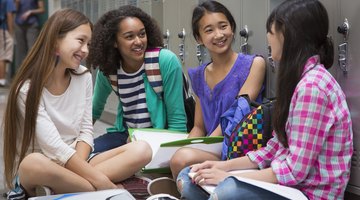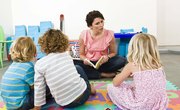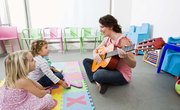Cultural diversity activities help foster attitudes of acceptance in middle school students that can lead to more inclusive communities. Providing awareness of other cultures to middle school students is the first step toward teaching them to respect people from all backgrounds and nationalities. Cultural diversity activities can be entertaining for middle school students, as well as educational.
What’s in a Name?
Cultural diversity doesn’t have to start with the study of exotic people or places. The Diversity Council of Rochester, Minnesota, suggests the simple activity for middle school students of exchanging information about their own names in small groups. Children grow up hearing stories about the meaning and origin of their given names or nicknames. By encouraging students to share this information with classmates, they can start a dialogue about the diverse backgrounds they come from within the comfort zone of a small, familiar group.
Create a Culture
A hands-on approach to understanding the components of different cultures is to have middle school students create a culture of their own. This activity can be done individually or in small groups. Created by a middle school teacher for the Missouri Department of Education, this activity allows students to be creative while learning about all aspects of a culture and how these pieces are related.
Teachers can begin this activity by discussing the various components of a culture, using America as an example. What is the primary language in America? What foods do people eat here? How do people dress? What symbols represent America? How does America differ from other countries? The class discussion should help students develop an overall concept for what makes up a culture.
Next, students should brainstorm about creating a culture. To do this, they will use a poster board to demonstrate aspects of their culture, including language, food, clothing, architecture, sports, religion, entertainment, flags and other symbols of nationality. Students should create a map of where all of these things take place and how they intersect, and incorporate as many of these factors as possible into the presentation.
Multicultural Fair
The multicultural fair, suggested by the Educator’s Reference Desk, is informative and entertaining. Middle school students each choose a country to represent at a multicultural fair. After choosing a country, a student will research all aspects of its culture and create a display highlighting cultural factors such as language, food, clothing and so forth. On the day of the fair, encourage students to dress in clothing representative of his or her country and provide food or other tangible components of the culture.
Chain of Diversity
The chain of diversity encourages middle school students to recognize the diverse aspects of their own classmates. Penn State recommends this activity to help students understand that not only people’s similarities but also their differences bring them together.
Within the context of a middle school classroom, the chain of diversity is conducted by giving each of the students four to five strips of construction paper. On each, the student should write down one way he or she is similar to other people in the class and one way he or she is different from other people in the class. After completing this, students should be encouraged to share what they have written and then use each strip to be a link in a chain. Afterward, they should loop the paper strips together and then hang them around the classroom to remind students that they are bound by both their similarities and differences.
Related Articles
References
Writer Bio
Beth Griesmer’s writing career started at a small weekly newspaper in Georgetown, Texas, in 1990. Her work has appeared in the “Austin-American Statesman,” “Inkwell” literary magazine and on numerous websites. Griesmer teaches middle school language arts and science in Austin, Texas.











